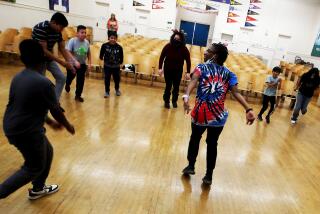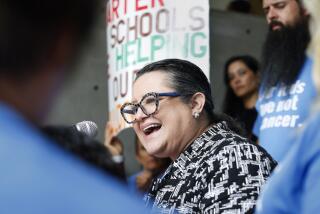School Officials Gird for Battle on Year-Round Plan
Already fielding angry calls from parents threatening lawsuits and recall elections, the Los Angeles Board of Education girded for battle Tuesday over its decision to place every district school on a year-round calendar in 1989.
Officials of the seven-member board said, however, that the four members who voted for the year-round plan on Monday will stand firm behind the decision, which will radically alter the traditional model of the September-to-June school year--and disrupt the normal summer vacation--for hundreds of thousands of students and their families across the school district.
âI have no reason to doubt that (the decision) will stick,â said Westside board member Alan Gershman, who cast one of the three votes against the plan. âItâs my sense that the four-vote majority is solid on this and is going to hold.â
Gershman and other board members said the district now must concentrate on the monumental planning job ahead to prepare for the big switch, which would make the 592,000-student Los Angeles district the largest year-round district in the country.
East San Fernando Valley board member Roberta Weintraub, a staunch opponent of year-round schools who voted against the plan, said she has difficulty accepting the decision, which she termed âridiculous.â
The veteran board member, who was elected on an anti-busing platform, said the year-round plan is potentially as devastating to the district as mandatory busing was in the late 1970s, when thousands of parents removed their children from the district and sent them private schools.
Barbara Romey, a Northridge parent who helped lead a campaign against year-round schools last year, said a citywide organization of parents opposed to year-round programs will meet next week to discuss a strategy for blocking implementation of the plan. Last year, the group, called Parents for Quality Education, collected 20,000 signatures to place an initiative on the ballot that would allow voters to decide whether they wanted year-round schools. The attempt failed because not enough signatures were collected, but Romey said she will encourage the group to explore other tactics.
âWe will protest in the courts and in Sacramento. . . . We will sit down with our legislators and see how they can stop (year-round schools), just like Proposition 1 stopped forced busing,â she said. âIâm hoping that parents will fight.â
The district already operates 93 year-round campuses, 85 of which were placed on the program because they are overcrowded and need the extra space that a year-round calendar creates. One-quarter of the districtâs students attend those schools.
The plan adopted by the board would require all traditional two-semester schools to switch to a year-round calendar. The board has not yet chosen a calendar, but that is high on the list of decisions that need to be made soon, members said Tuesday.
Handles More Students
A year-round calendar allows a school to accommodate more students than a traditional calendar by providing a system of alternating groups of students throughout the year, with shorter vacation breaks interspersed throughout the year. The groups or tracks of students would rotate vacation times in this so-called multitrack system.
Schools that are not overcrowded would use a modified version of the same calendar, which is called the single-track approach. Under this system, every student in the school would have the same schedule of vacations, and school time that would be identical to the schedule followed by some students using the multitrack program.
The single-track approach would be used by the majority of district schools. It does not create additional seats. It would, however, allow those schools to be in synchronization with the multitrack campuses and would encourage providers of youth services to offer their programs year-round, district officials said.
There are at least five types of year-round calendars, each with its own set of advantages and disadvantages. Certain calendars, when adapted for schools that are not crowded, resemble a traditional schedule, offering a summer break almost as long as the vacation that students in regular schools are accustomed to.
Service Providers
Board members said the district must immediately begin to meet with providers of youth services, from the Girl Scouts to parks departments to private child-care centers, to seek their cooperation in making the transition to a year-round schedule.
Some board members have begun such discussions on their own and said they have received positive responses. The PTA is expected to support such efforts.
Artis Slipsager, president of the PTAâs 31st District, which covers the San Fernando Valley, said the organization plans to expand a child-care program it has operated for several years. Staffed by paid professionals, the Latchkey Program currently provides child care for 600 children at 13 schools. The cost is $32.50 a week per child for all-day care.
Slipsager said it would not be difficult to extend this service to all schools in the Valley. She added that she is optimistic that other agencies will adapt their services to serve students year-round.
âWe have begun exploratory talks with various youth agencies in the community,â such as the Boy Scouts, Girl Scouts and Camp Fire Girls, she said, âand they indicated they probably could provide their services (on a year-round basis). We were very encouraged.â
Mayor Not Contacted
A spokeswoman for Mayor Tom Bradleyâs office, Dee Dee Meyers, said city officials want to meet with district staff members about coordinating city services such as parks and recreation programs. But she said the mayorâs office has not yet been formally contacted by the district.
âWe certainly are willing to sit down and discuss how we can help provide better services that go along with the new calendar,â she said.
The first step the board will take will be to determine procedures for selecting members of a task force to study possible year-round calendars and to recommend one schedule that will be suitable for all grade levels.
The task force will be composed of representatives from the business community and child-care agencies, as well as teachers, students, parents and administrators.
Newly elected Harbor-area board member Warren Furutani, who voted in favor of the year-round plan, said he hopes that the board will also begin to emphasize to the public the potential educational benefits of year-round school, which he said have been overlooked.
Successful Programs
âI really feel we have to come out on the educational issues because we havenât made an academic argument for it,â he said. âWe do have some very successful year-round schools.â
One such school is South Gate Junior High, where test scores have risen during the several years it has operated on a year-round calendar, Furutani said. âThat is only one of many schools in the Southeast area that seem to be thriving in this program.â
All schools in South Gate run on a multitrack, year-round program. According to Furutani, city services and child-care providers have accommodated the schedule.
âThe key to the success of the schools in South Gate is that the whole community is in support of the calendar and has synchronizedâ with the school schedule. âThe district could take whatâs happened there as an example.â
YEAR-ROUND SCHOOLS: PROS AND CONS
THE DECISION: Beginning in July, 1988, 17 schools across the Los Angeles Unified School District will have the option of adopting year-round schedules. The following July, all 618 L.A. Unified elementary, junior high and high schools will go on year-round calendars.
THE CALENDAR: A school board-appointed task force will work out a calendar from among several options. One possibility is the so-called 60/20 plan in which students attend classes for 60 days, followed by 20 days of vacation. Severely overcrowded schools are on a multitrack schedule, with one-quarter of the student body on vacation at any one time during the year. Less-crowded schools use a single-track schedule, with all students in class at the same times during the year. Vacations may be in winter, spring and fall instead of concentrated in summer months.
CURRENT YEAR-ROUND SCHOOLS: Ninety-three district schools already are on year-round schedules; 85 are on multitrack calendars. Los Angeles accounts for 38% of the total number of year-round schools in the state. Other Southern California cities with some or all of their schools on year-round schedules include: Oxnard, Montebello, Rosemead and South Gate. A number of other districts, including Long Beach Unified, are considering year-round calendars.
COSTS/SAVINGS: Air conditioning could cost up to $300 million. But the district will save on busing costs, which average about $1,000 annually for each of the 30,000 students bused.
ADVANTAGES: Creates thousands of additional classroom seats. Proponents say students retain more of what they learn because vacation breaks are shorter, and teachers avoid burnout and could earn more money by working year-round. Some students say they prefer spending the summer in air conditioned classrooms instead of hot homes.
DISADVANTAGES: Installing air conditioning is expensive and complicated. Family vacations, child care, camps, Little League and other services and activities may be disrupted. Summer jobs may be harder to find--and to keep--although some students already on year-round calendars say it is easier to find work because there is less competition. School sports programs may suffer, although most year-round students are allowed to participate in sports even if they are on vacation. Opponents say high school seniors might be hurt because their transcripts might not be available in time for college application deadlines.
More to Read
Sign up for Essential California
The most important California stories and recommendations in your inbox every morning.
You may occasionally receive promotional content from the Los Angeles Times.











